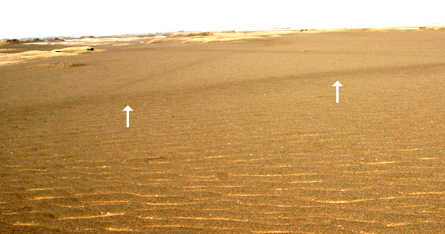The ephemeral dark trails left in desert sand by dust devils are produced when the whirlwinds blow tiny particles of lighter-colored silt and dust off larger sand grains, a new study shows. Even removing a layer of dust and silt only a few micrometers thick can produce a dark trail visible with satellites, recent field studies suggest.

Dust devil trails have been spotted on space-based images of both Mars and Earth (SN: 5/8/04, p. 302). Oddly, scientists are much more familiar with the phenomenon on Mars, says Dennis Reiss, a geographer at Westfälische Wilhelms Universität Münster in Germany.
Not only are dust devils larger and the resulting trails wider on the Red Planet, the atmospheric processes that erase such blemishes are weaker there. While Martian trails may persist for weeks, those on Earth typically disappear in a day or two. “We’re lucky to see them at all on Earth,” Reiss adds.
In the July 28 Geophysical Research Letters, Reiss and his colleagues document their analyses of a fresh dust devil trail. For their first-of-its-kind field study, the researchers went to a desert region of northwestern China, where such trails are commonly seen on satellite images and are easily detected at ground level. After finding a dark trail that hadn’t been seen the previous afternoon, they used handheld microscopes to look at sand in the trail and at a comparable site just a few meters outside the dark streak.
While much of the sand outside of the trail was coated with micrometer-sized particles of silt, clay and dust, most of the sand inside the trail had been whisked clean of such particles. Because those tiny surface particles typically are light-colored, the cleansed sand, when seen from a distance, appears much darker than the nearby material, says Reiss. The team estimates that if the material removed by the dust devil were instead spread evenly over the whirlwind’s path, that layer would measure about 2 micrometers thick.
Scientists have made similar observations of a dust devil trail on Mars using instruments on a robotic rover, but those sensors didn’t have nearly the resolution of the microscopes used in the field study in China, says Reiss.
The team’s new observations confirm what’s been seen on the Red Planet but “are much more ‘up close and personal’ than what’s been done on Mars,” says Steve Metzger, a geologist from Reno, Nev., who is affiliated with the Planetary Science Institute in Tucson.
While some of the tiny particles clinging to sand grains could have been blown free by the highly variable winds inside the dust devil, most were probably pounded loose from the sand grains as they saltated, or bounced along the ground, says Metzger. Via this “impact splash” phenomenon, a dust devil can easily loft several cubic meters of dust into the air, he notes.
And while large quantities of the dust and silt likely ended up airborne, some of the tiny particles could have been driven down into the gaps between sand grains, he notes. With the data gathered so far, it’s difficult to estimate what fraction of dust and silt might be driven into those subsurface voids, says Reiss.






